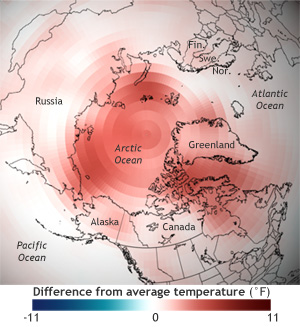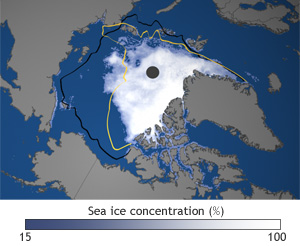Arctic continues to break records in 2012: Becoming warmer, greener region with record losses of summer sea ice and late spring snow
Posted on 23 December 2012 by John Hartz
This is a reprint of a news release issued by the US National Oceanic and Atmospheric Administration (NOAA) on Dec 5, 2012.
The Arctic region continued to break records in 2012—among them the loss of summer sea ice, spring snow cover, and melting of the Greenland ice sheet. This was true even though air temperatures in the Arctic were unremarkable relative to the last decade, according to a new report released today (Dec 5, 2012).

Difference from average temperature in the Arctic from 2001-2011 compared to the long-term average (1971-2000). Credit: NOAA
"The Arctic is changing in both predictable and unpredictable ways, so we must expect surprises,” said Jane Lubchenco, Ph.D., under secretary of commerce for oceans and atmosphere and NOAA administrator, during a press briefing at the American Geophysical Union annual meeting in San Francisco, Calif. “The Arctic is an extremely sensitive part of the world and with the warming scientists have observed, we see the results with less snow and sea ice, greater ice sheet melt and changing vegetation.”
Lubchenco participated in a panel discussion that presented the annual update of the Arctic Report Card, which has, since 2006, summarized the quickly changing conditions in the Arctic. A record-breaking 141 authors from 15 countries contributed to the peer-reviewed report. Major findings of this year’s report include:
- Snow cover: A new record low snow extent for the Northern Hemisphere was set in June 2012, and a new record low was reached in May over Eurasia.
- Sea ice: Minimum Arctic sea ice extent in September 2012 set a new all-time record low, as measured by satellite since 1979.
- Greenland ice sheet: There was a rare, nearly ice sheet-wide melt event on the Greenland ice sheet in July, covering about 97 percent of the ice sheet on a single day.
- Vegetation: The tundra is getting greener and there’s more above-ground growth. During the period of 2003-2010, the length of the growing season increased through much of the Arctic.
- Wildlife & food chain: In northernmost Europe, the Arctic fox is close to extinction and vulnerable to the encroaching Red fox. Additionally, recent measurements of massive phytoplankton blooms below the summer sea ice suggest that earlier estimates of biological production at the bottom of the marine food chain may have been ten times lower than was occurring.
- Ocean: Sea surface temperatures in summer continue to be warmer than the long-term average at the growing ice-free margins, while upper ocean temperature and salinity show significant interannual variability with no clear trends.
- Weather: Most of the notable weather activity in fall and winter occurred in the sub-Arctic due to a strong positive North Atlantic Oscillation, expressed as the atmospheric pressure difference between weather stations in the Azores and Iceland. There were three extreme weather events including an unusual cold spell in late January to early February 2012 across Eurasia, and two record storms characterized by very low central pressures and strong winds near western Alaska in November 2011 and north of Alaska in August 2012.
“Popular perceptions of the Arctic as a distant, icy, cold place that has little relevance to those outside the region are being challenged”, said Martin Jeffries, co-editor of the 2012 Report Card and Arctic science adviser, Office of Naval Research & research professor, University of Alaska-Fairbanks. “As snow and ice retreat, the marine and terrestrial ecosystems respond, and talk of increased tourism, natural resource exploitation, and marine transportation grows. The Arctic Report Card does a great service in charting the many physical and biological changes.”

Ice concentration on Sept. 16, 2012, compared to previous record low (yellow line) and historic median extent (black line.) Credit: NOAA/National Snow & Ice Data Center.
Apart from one or two exceptions, the scientists said the air temperatures were not unusually high this year relative to the last decade. Nevertheless, they saw large changes in multiple indicators affecting Arctic climate and ecosystems; combined, these changes are strong evidence of the growing momentum of Arctic environmental system change.
The record-breaking year also indicates that it is unlikely that conditions can quickly return to their former state.
“The record low spring snow extent and record low summer sea ice extent in 2012 exemplify a major source of the momentum for continuing change,” added Jeffries. “As the sea ice and snow cover retreat, we’re losing bright, highly reflective surfaces, and increasing the area of darker surfaces—both land and ocean—exposed to sunlight. This increases the capacity to store heat within the Arctic system, which enables more melting—a self-reinforcing cycle.”
In 2006, NOAA’s Climate Program Office introduced the State of the Arctic Report which established a baseline of conditions at the beginning of the 21st century. It is updated annually as the Arctic Report Card to monitor the often-quickly changing conditions in the Arctic. To view this year’s report, visit http://www.arctic.noaa.gov/reportcard/.































 Arguments
Arguments























 0
0  0
0






Comments